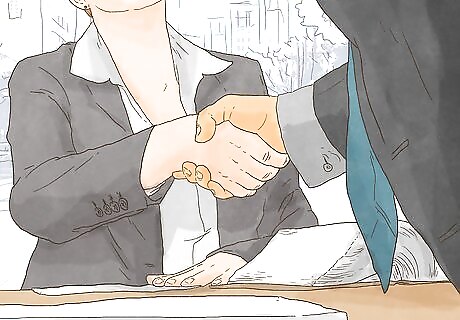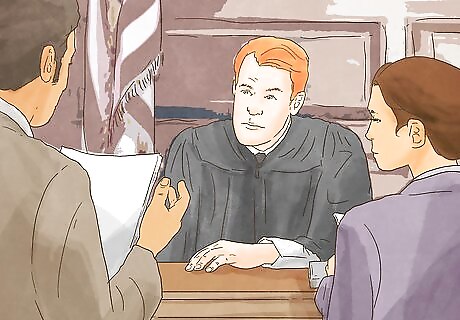
views
Choosing a Guardian

Outline the guardian's responsibilities. Your court clerk or family law facilitator may have a checklist you can use to review the basic responsibilities of a guardian under your state's law and determine how they apply to your situation. Generally, guardianship enables other adults such as grandparents to care for children without terminating parental rights, as would occur if the child were adopted. Guardianship can provide stability for children while their parents or other custodial family are in the midst of change or upheaval. For example, if a single parent goes to jail, the child's grandparents may want legal guardianship of the child. Once the parent is released from prison, she may desire to have that guardianship transferred back to her. Legal guardians essentially act as a parent for the child, making all the basic decisions such as schooling and medical treatment for that child. Keep in mind that legal guardianship technically does not include financial responsibility for the child – this responsibility remains with the child's parents provided they are alive and capable of providing financial support.

Talk to the child. If the child is old enough to form an opinion on her guardianship, she should be consulted regarding the people you have in mind to transfer guardianship. If the court appoints a guardian ad litem – a neutral third-party who evaluates the situation and represents the child's best interests in court – one of the things he will consider is how will the child gets along with the potential guardian.

Interview potential candidates. After you've made a preliminary decision regarding who is best suited to take care of the child, have an extended conversation with each one to make sure they understand and are capable of fulfilling all of a guardian's responsibilities. As a basic matter, a guardian must be of legal age in your state – typically 18, but sometimes older. She also must have a genuine interest in your child's welfare and be mentally and physically capable of caring for the child. You also want to make sure that you're comfortable with the guardian's cultural background and beliefs. For example, if the child is being raised in an Orthodox Jewish household and tradition, you may not want to transfer guardianship to someone who is an avowed atheist.

Get the required forms. Each state typically has forms that are pre-approved by the state's court system for a guardianship petition, which you can get from the court clerk or at a legal aid or family law clinic. Since each court may require different forms, make sure you check at the specific court where you intend to ask for a transfer of guardianship. Typically, you want to use the court in the county where the child lives. If you go to the clerk's office and explain that you want to transfer guardianship of the child, the clerk should be able to provide you with the appropriate forms. Along with the main petition for guardianship, you also may have to fill out other forms such as a child custody affidavit, through which you disclose where the child has been living for the past five years and the names and addresses of anyone else such as other close family members who may have a legal interest in your petition. Typically the forms come with step-by-step instructions for filling them out. Reading those instructions thoroughly and making sure you understand them before you start filling out the forms will save you a lot of time and duplicated effort.

Gather information. Pull together information about the child and financial documents you may need based on your outline of the guardian's responsibilities and the form itself. You need to make copies of all of these documents. Some of them you must include with the forms you submit to the court; others contain information the new guardian will need to carry out her responsibilities.
Filing Guardianship Papers

Fill out your forms. Provide all the information required, taking care that your answers are thorough and honest. The person who fills out and files the guardianship petition need not be the person who will become guardian of the child if the court approves the petition. If you are the current guardian of the child and wish to transfer guardianship to another person, you may fill out the forms and propose that person become the child's new guardian.

Have your forms reviewed by an attorney or family law expert. Even if you can't afford an attorney to represent you through the entire guardianship process, you may be able to have someone look over your forms and verify that you've filled them out correctly. You typically don't have the right to a free attorney in family law cases. However, some states such as Maine provide free attorneys for parents in guardianship cases.

Sign your forms. Once you're satisfied with your answers, sign and date your forms. In some states, you may be required to sign your forms in the presence of a notary. If you were required to fill out any affidavits, these must be signed in front of a notary because they are written under oath. After you've signed your forms, make enough copies so you have one copy for your records and additional copies for anyone you're legally required to notify of the petition.

File your forms with the appropriate court. Begin the court process by taking your forms and your copies to the clerk's office of the court that will hear the guardianship case. You must pay a filing fee to initiate your guardianship case in the court. These fees vary among states and sometimes even among courts within each state. If you cannot afford filing fees, you should ask the clerk for an application to have the fees waived. You must disclose details about your income and finances, but if the judge approves your application you won't have to pay any filing fees for your guardianship case.

Notify any other parties. Most states require you to provide notice to parents or other close family members of the child that you are asking the court to transfer guardianship. You provide legal notice by having a sheriff's deputy deliver the papers you filed to the party personally, or by mailing the papers using certified mail. Either method ensures you have proof that the required parties knew about your petition. You also may be required to send legal notice to the child if she is over a certain age and has not signed the petition indicating her consent. In Maine, for example, you must serve copies of the forms you filed to the child if she is over the age of 14.
Attending Your Guardianship Hearing

Organize your documents and information. Make copies of all the documents you've filed with court, as well as any other documents you intend to use as evidence, and keep them together so you can take them with you to court. If your case is contested, consider hiring an attorney to represent you in court. Guardianship law can be complicated, and if someone disagrees with the transfer of guardianship you may need an attorney experienced in guardianship cases to look after your best interests and the best interests of the child. You may be able to find free or reduced-fee legal assistance if you don't believe you can afford attorney's fees. If you're concerned about your ability to afford an attorney, check your local legal aid or family law clinic for resources.

Research your state's law. Before you attend your hearing, make sure you have a good understanding of the "child's best interests" legal standard as applied in your state. Once you get to court, you have the burden of proving that your guardianship is in the child's best interests. Depending on the situation, you also may have to prove that the child's parents are incapable of caring for the child. Generally, the judge will consider the relationship between the child and the proposed guardian, the moral character of the proposed guardian, and who can best fulfill the child's physical and emotional needs with stability and continuity. Judges also consider the preference of the child, the child's ties to his community, involvement in school, and how a transfer would affect those ties and involvement.

Cooperate with the guardian ad litem. If the judge appoints a guardian ad litem, make yourself available to her and answer any questions she might have as she evaluates the case. A guardian ad litem is a lawyer, psychologist, or other professional who has training in evaluating the needs of children in complex family situations. She will interview all parties involved as well as the child. The guardian ad litem also may complete background checks on you or other adults living in your household, or ask to speak with friends and co-workers about you. Ultimately, the guardian ad litem compiles the information she has gathered and issues a written report to the court that outlines her conclusions on the best interests of the child along with her recommendation on whether guardianship is appropriate for the child in this case. In some cases, the court may order a home visit or inspection of the location where the child would live if guardianship was transferred.

Appear in court. You must appear in court at the date and time the hearing on your guardianship petition has been scheduled. In some circumstances, you may be able to avoid a protracted hearing if all interested parties agree to the guardianship. Although the judge still has to approve the guardianship, the process typically will be quicker and less formal.

Present your case. Since you filed the guardianship petition, you typically will be given the opportunity to explain to the judge why you're requesting the court transfer guardianship of the child. Since guardianship usually lasts until a child's 18th birthday, transferring guardianship of a child from one guardian to another can be difficult even if all parties agree. The judge must review the transfer and will not approve it unless she believes it is in the best interests of the child, considering all circumstances.

Receive the judge's order. After the hearing, the judge will issue an order either granting or denying your petition. If the judge grants your petition, you may be required to fill out additional forms accepting or acknowledging the guardianship. You also may be required to file annual reports with the court. The judge or the clerk typically will let you know of any further requirements or filings. Most states require that you sign an affidavit stating that you understand and accept the responsibilities of guardianship and will fulfill those responsibilities in accordance with the best interests of the child. Once the judge's final order is entered, make enough copies so you can provide them as needed to places such as the child's school or doctor's office.


















Comments
0 comment